Benefits
• Tones Spine
• Massages and strengthens abdominal organs
• Makes shoulders more flexible
• Strengthens arms and legs Builds endurance Contraindications
Contraindications
• Tendency to dislocate shoulders Chronic shoulder injuries
• Pregnancy
• Unmanaged high or low blood pressure
• Herniated lumbar discs
• Positional vertigo
Intro
Intro
Earlier this year while watching Jazz, filmmaker Ken Burns's documentary series, I was struck by a comment from Chicago jazz great Eddie Condon. A leader in the desegregation of jazz, Condon observed that when white musicians first came on the scene they were eager to play jazz but "stiff with education." I was reminded that as we in the West embrace the ancient tradition of yoga, we need to leave room for the earthy elements that keep a yoga practice as playful as it is serious.
Contemporary yoga, highly influenced by Western culture, has taken the practice to whole new levels of anatomical precision. And there's no doubt about it: Technique and form matter. Proper form harnesses our energy and puts it to good use. Biomechanical details guide us around obstacles and help us avoid pitfalls. Yet if we become too attached to form, we risk losing the simple pleasures and insights of mindful movement and may end up perpetuating the barrier between body and mind that, ideally, hatha yoga breaks down. We can easily forget yoga is a dance.
In this column I'll describe a vinyasa–the word can signify a particular position or movement but is most often used to refer to a series of movements consciously linked by the breath–a wonderful example of how a sense of dance can be preserved in yoga. This series of poses evolved, I'm sure, from yoga practiced less with ambition than with curiosity and a compelling impulse to see beyond the familiar boundaries of asana.
Though the sequence can be great fun, it requires both shoulder and spinal flexibility, so I advise waiting until the latter part of your practice when you are thoroughly warmed up before trying it. To prepare for the sequence you can practice backbends and shoulder openers. Also, as you progress through the sequence, keep in mind that you don't have to complete the whole vinyasa. The point is just to get into the flow and explore.
Demonstrations
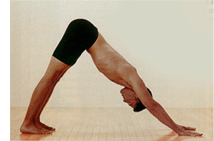
1. Adho Mukha Svanasana
In Child¹s Pose, curl your toes under and extend your arms forward. Inhale and lift your hips back and up to raise your knees off the floor. Exhale, extending back and up with your hips to lengthen your spine. Refine this movement until your legs are as straight as possible. Continue to press your hands down, keeping your head between your arms rather than dropping it toward the floor.
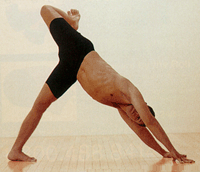
2. Creating the Twist
In Adho Mukha Svanasana, raise your right leg, bend the knee, and open your right hip toward the ceiling. Shift your weight to your left hand, come onto your right fingertips, and let your right leg hang behind you to create a spinal rotation. Breathe steadily and keep reaffirming the length from your hands to your hips to insure smooth shoulder rotation. Deepen the twist, gradually bringing your right foot as close to the floor as possible.
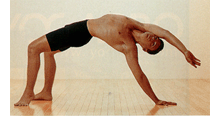
3. Flipping the Leg
From Exercise 2, twist until you can bring your right foot to the floor. Let your right hand lift and bring the arm next to your head. Place your feet parallel and slightly wider apart than your hips. Lift your hips and pull them over the feet as you rotate your upper body and place your right hand on the floor, fingers facing your feet. Turn your left hand to complete the backbend. If you can¹t bring the right arm to the floor, hold the twist for several breaths, then reverse out of it back to Downward Dog, as described in Exercise 5.
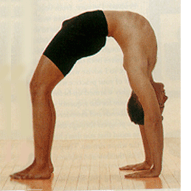
4. Urdhva Dhanurasana
(Upward Bow Pose)
Balancing the weight evenly between your hands and feet, breathe steadily, making sure you complete each exhalation. Draw your inner groins into your hips, gently lift your tailbone, and create length in the backs of your calves. Move your inner arms toward your legs and roll your top shoulder blades toward your hips as you bring your shoulders as close to directly over your wrists as possible. Let your head hang freely. Stay in the pose for several breaths, becoming comfortable and steady.
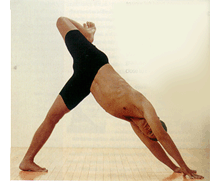
5. Flipping Back to Downward Dog
To come back to Adho Mukha Svanasana, turn your left hand toward your right. Keep your fleet planted and press your left hand firmly into the floor as you rotate your chest strongly to the left and pull the right hand from the floor. Then pivot your left foot to face your hands and exhale to gently rotate the rest of your body back to Downward Dog. Repeat the whole sequence on the other side.
Engaging the Shoulders
Engaging the Shoulders
The series begins with Adho Mukha Svanasana (Downward-Facing Dog Pose) . Though a staple of almost every hatha yoga practice, a fully satisfying Downward Dog can be incredibly elusive even for veteran practitioners. I suggest that you begin in Balasana (Child's Pose) , sitting on your heels and bending forward until your torso rests on your legs, your head on the floor, and your arms at your sides.
To become quiet and focused, close your eyes and tune in to your breathing. Do you feel your body move slightly in response to each breath? With that movement, you're already dancing. The pulse of the breath, like a drum, serves as the rhythm for all our movements. Its beat is always there, but our bodies can become so conditioned to thinking and analyzing that we forget to simply listen for it–and to feel the constant internal dance. Child's Pose, in its simplicity, puts forth few obstacles to such internal inquiry. In quiet poses like this, the internal rhythm is so obvious that I can't help but wonder if the original yogis became so fascinated by their own inner rhythms as they sat in meditation that eventually they couldn't contain an urge to express that pulse externally in the movements we call asanas.
Allow your sense of inner rhythm to grow in Child's Pose, staying focused on your breath as you extend your arms forward and straighten them. Place your hands on the floor about shoulder-width apart. Inhale to lift your hips off your heels and exhale as you come to all fours. Since good shoulder rotation will be a necessity in the coming vinyasa, let's pause to investigate the arms and shoulders. Not knowing how to best use the shoulders is a major stumbling block in yoga for many people, but with time and interest anyone can undo less than optimal habits and replace them with better alignment, movement, and ease.
Keeping your head at shoulder level, spread your fingers wide open. To reduce weight on the wrists, root the balls of your fingers into the floor, especially the ball of the index finger and the pad of the thumb. This movement activates the arches of the hands, improving both stability and buoyancy in the wrists, elbows, and shoulders.
Arrange your arms so that the inner elbows face slightly forward. If you are very flexible in your shoulders, watch that you don't roll your elbows too far forward, an action that can compress the shoulders. Next, extend from the side ribs through the triceps (the muscles on the back of the upper arm) and continue to rotate your upper arms outward. These actions take on added strength when you simultaneously reroot the balls of the fingers. Grounding the hands rotates your lower arms slightly in, which may seem to contradict the external rotation of the upper arms. Actually, it doesn't; your elbow joints are designed with ample flexibility to allow both these actions, and your arms will be more stable as a result of making them.
Externally rotating your upper arms also expands the chest and broadens the back, permitting the muscles of the thoracic spine to engage more fully. Consciously slide your inner shoulder blades away from the ears to allow the upper spine to move forward into the chest, reducing the convex curve of your upper back. You will need to pay attention to this action as you move into Downward Dog, where the challenge of maintaining shoulder alignment increases.
Now turn your focus to your breathing again, this time trying to sense its rhythm as movement in the muscles along the spine, perhaps even letting it move your spine a bit. Be curious about how the spine moves; explore its capacity to bend, arch, rotate, lengthen, and shorten. You can investigate these possibilities in any way you wish. Your movements need not be large; indeed, your body may appear to be static. But notice if you resist the idea of such improvisation. If you become dogmatic about constantly enforcing alignment and technique, valuable as they may be, form can become an imposition that masks inner rhythm and makes every unplanned movement suspect instead of an opportunity for learning.
Extending the Spine
Extending the Spine
Now begin to lengthen your spine toward your tail. Informed by your recent explorations into the spine's snaky nature, perhaps you can feel each individual vertebra move. Slightly drop your tailbone, letting its weight reduce the arch in the lumbar spine, and slightly pull the lower abdomen in toward your back.
Turn your toes under and inhale as you lift your knees off the floor, then exhale and push your hips up and back, an action that will extend your shoulders and spine and put more weight on your feet. Keep your knees bent and, as you did while on all fours, investigate the internal, rhythmic movement of your breathing and the gentle stretching of the spinal muscles. Continue to lengthen your spine toward the tailbone.
This asana imitates the movement of a dog waking up from a nap, so enjoy a luxurious, yawning stretch, as though you were newly awake. Before settling into stillness, feel free to stretch in any way that feels good to you; keeping your knees bent will give you more freedom to wiggle your hips and spine. If you strongly extend both arms and legs, Downward Dog will continue to awaken the spine and infuse it with energy.
Ideally, in Downward Dog your weight should be evenly distributed between the hands and feet. If you have more weight on your hands–a common problem–try this: Focus considerable attention on grounding your legs. This instruction may sound simple, but it really isn't. The most frequent error I see in Downward Dog is jamming the shoulder girdle straight down toward the floor. If you do this, you'll sabotage your ability to root the legs and feet effectively.
Instead, raise and widen your shoulders slightly, then exhale as you rotate the base of your pelvis skyward. Continue to lengthen your spine toward your hips as you do this to avoid compressing the lumbar spine. Explore this action for several breaths and then, on an exhalation, straighten your legs, bringing your heels to the floor if possible. This action will further elongate your shoulders.
Even if your heels do not yet reach the floor, you can bring more of your weight toward your feet. With each new exhalation lengthen your spine toward the tailbone and take your heels back and down while spreading the ball of each foot wide to activate the arches. If you are quite free in your hips, rooting your heels will be sufficient action to generate strength and a buoyant inner lift from the ankles through the knees to the hips. If your heels do not rest on the floor or you do not feel a lift in your legs, focus on extending your calves down from the backs of the knees to the heels and on rooting the balls of the feet. Consciously moving your femur bones toward the backs of the legs also helps. If you still feel more weight on your hands than on your feet, bend your knees to make all these corrective movements easier.
Solidly grounding your legs will both lengthen your spine and stretch your shoulders. Even though the shoulders are now as fully extended as you can make them, maintain a hint of the feeling that your shoulder girdle is still slightly lifted by imagining the inner armpits being pulled toward the back shoulders as though by a string. Now that your shoulders are better aligned, exhale and extend from your side ribs through your triceps and forearms so strongly that you transfer some of your weight forward on the hands, placing slightly more weight on the balls of the fingers than the heels of the hands.
Continue to rotate your upper arms outward, as you practiced earlier, to avoid compressing your shoulders and upper spine. If your arms resist external rotation, again lift the shoulders slightly toward the ceiling. Also, instead of diving your head down, keep it positioned between your upper arms. Both these actions help you avoid hyperextension of the shoulder and excessive internal rotation. Especially if you tend to hyperextend your shoulders, this approach may make you feel restrained at first, but it will also make your shoulder joints safer and your pose more balanced.
Refining the distribution of weight between the arms and legs is a constant process, as is balancing the action of the hips and shoulders. Let the rhythm of your breathing be your constant ally in finding balance within your pose. Feel how each inhalation allows the body to expand, while each exhalation sends currents of movement pumping out through the limbs.
As your pose grows more steady and quiet, close your eyes and turn your attention to your belly, where the rhythm of the breath can usually be sensed quite easily. Let the breath create a sense of inner space and power within the pelvis. Feel how the natural release provided by the exhalation results in the muscles behind the abdominal organs being pulled back into the spine to generate a lift. This lift can be quite buoyant, almost like a balloon floating into the sky. As you catch a ride on that action, imagine that your limbs are not holding you up, they are holding you down!
When you can no longer maintain the pose with steady comfort, come down and rest for a minute or so in Child's Pose before returning to Downward Dog and beginning your flow toward Urdhva Dhanurasana (Upward Bow Pose).
Twisting the Spine
Twisting the Spine
Once you are back in Downward Dog, stay mindful of a few pointers that are crucial to the coming sequence. First, keep pushing your hips firmly away from your shoulders. Second, keep your shoulders extended and aligned as you have practiced. Third, don't forget to breathe. And fourth, remember this is a dance: Have fun!
In Downward Dog, turn your left hand farther to the left and strongly root it into the floor. Though turning your hand is not absolutely necessary, it will help you achieve the shoulder rotation you'll eventually need to move into Urdhva Dhanurasana. Next, raise your right leg, bending the knee and swinging it up and behind you so your right hip lifts and turns your abdomen with it, beginning the spin of the belly and spine that will eventually take you to Urdhva Dhanurasana. But let's not focus on the backbend just yet. First, enjoy this fabulous spinal twist.
Relax your leg and let it hang, allowing its passive weight to tug on your right hip and roll your abdomen farther to the right. Focus more on letting go than on trying, adopting a go-with-the-flow attitude that invites a sense of curiosity as you move off the beaten path. Keep extending back through your hips as you use your breath to soften the muscles along your spine and make its movement more fluid. As before, explore gently moving the spine to help release holding patterns. Try to feel which part of your back is tightest and give it extra attention, "sweet-talking" it with your breath.
When you have rotated the spine as deeply as possible, lift onto your right fingertips to create even more room for the hips and chest to turn. You can also deepen the twist by bending your left knee and lifting up on tiptoe with the left foot. With these actions, you can bend more deeply at the hip and probably coax a bit more movement in the spine until, finally, your whole torso revolves, your right foot hovers just off the floor, your heart faces up, and you can look under your arm.
All the while, continue to move your hips away from the shoulders. Of course, the deeper the twist, the farther your torso arcs backward, which can bring up the fear of falling. Consciously feel any fear you may experience, strongly root your hand and foot, and release into the twist instead of focusing on the impending backbend. I encourage you to try this much of the sequence several times to get comfortable with hanging backward.
When you feel ready to take the right leg the whole way to the floor, take a breath in and extend your hips strongly away from the shoulders; on your exhalation, let the twist flip your leg all the way over. As you do this, your right hand will leave the floor.
Now comes the most critical part of the flow. A common response at this point is to windmill your right arm to the floor by your side. Instead, rest your right arm by your ear. Don't rush through this position; settle in where you are for a moment. Make sure your breathing is steady, slowing it down and extending the exhalation if necessary. Next, position your feet parallel with each other, a little wider than hip-width apart. Then put your mind in your belly and once again lift the pelvis, feeling it pull the weight of the torso away from the arm and elongate the shoulder joint.
The shoulders are critically important in this transition. Unless you maintain length in the joints as you approach the backbend, your shoulders will lock up and stop you from completing the movement. Actually, going no farther than the twist is probably your best choice if you have chronic shoulder injuries, a tendency to dislocate your shoulder, or cannot yet lift into Urdhva Dhanurasana from the floor. If, for whatever reason, you decide that going farther is beyond your abilities, simply enjoy the twist for a few breaths, releasing into the deepest rotation possible. When you're ready to come out of the pose, roll your chest back around to the left, pivot your left foot forward so the toes face the hand, and gently bring your right arm and leg back over to Downward Dog.
If you do feel ready to progress to Urdhva Dhanurasana, wait until the spinal twist has deepened as much as possible. Then bend your knees and again push your hips strongly away from the chest to elongate the shoulders. You may have noticed that I keep repeating the instruction to move your hips away from the shoulders. That's because it is the single most important maneuver throughout this whole vinyasa and helps to avoid stressing the shoulders. The length in the shoulder that results from extending the hips away from the shoulders frees you up to rotate your upper spine deeply to the right and reach overhead to place your right hand on the floor in Urdhva Dhanurasana.
If you couldn't get enough extension through the left shoulder to pivot into Urdhva Dhanurasana on your first attempt, try again, this time more strongly pushing your hips away from your shoulders, bending the left elbow, and dipping the left shoulder nearer to the floor. Don't forget to stay focused on steady breathing. If you feel as though you can't create enough extension and rotation to complete the flip, return to Downward Dog: Inhale as you rotate your chest to the left, pivot your left foot forward, and exhale to gently roll your right arm and leg back to Downward Dog. Don't lead with the right leg: It won't work! You've got to start from the chest and let the twist reverse you back to Downward Dog.
However, if you've succeeded in placing your right hand on the floor, you'll need to pick up your left hand and pivot it so the fingertips face your feet. Adjust both hands so they are positioned properly–shoulder-width apart and with fingers pointing toward the feet–and settle into Urdhva Dhanurasana.
This backbend requires strength, flexibility, and surrender. Take a moment to establish a steady breath, with the mouth closed and the exhalation strong. Though you will not linger in Urdhva Dhanurasana, the pose is too important to glance over. Don't be surprised if you find Urdhva Dhanurasana approached this way easier than when you push up from the floor–and thus a better opportunity than usual to fine-tune the pose.
Consciously root your hands and feet to the floor, balancing the weight equally between them. Draw your front groins into the hips, move the inner thighs back, strongly ground your heels, and root the balls of your feet. Move your inner armpits toward the back shoulders to rotate your inner arms toward your ears, and widen your upper back as you extend your arms toward the balls of the hands. If you have difficulty widening your upper back, roll your shoulders back toward your tailbone and reaffirm the rotation of your inner arms. Although you're now upside down, can you feel that these are exactly the same actions you used in Downward Dog?
Exhale and let the chest bloom outward and upward to elongate the shoulders again; at the same time, if you're quite flexible be careful not to force your shoulders too far forward into hyperextension. Continue to breathe steadily as you release any tense muscles along your spine and adapt to the rich spinal arch this asana requires. You can continue to explore moving the spine as you did in Downward Dog, accompanying every movement with mindful breathing to enhance your liquidity and ease. Don't lose your connection with the internal rhythm of the breath. Yes, even in an asana as strong as this backbend, there's room to dance!
Whenever you're ready, begin your return trip to Downward Dog. If you have paid attention to the flow, you will, like Hansel and Gretel, have laid down breadcrumbs to mark your path. Returning to Downward Dog is simply a step-by-step reversal of the flow you followed to arrive in Urdhva Dhanurasana, and it's easier than you might think.
The most common mistake is trying to throw the right leg up and over. Instead, stay calm and methodical. Turn your left hand toward the right hand and press the left arm into the floor as you strongly inhale and roll your chest to the left, bringing the right hand off the floor. Pause and feel how the spine is now rotating to the left. Just pivot your left foot forward to face your hands, and the action of the twist will allow you to softly bring your right arm and leg back into Downward Dog. It's as simple as that.
Complete the vinyasa by doing the same sequence to the right. Explore the vinyasa, repeating it several times, first fast, then slow; even play with it by flipping your way across the room, rolling over and over in the same direction. Maintaining your playfulness and sense of adventure contribute to the sense of flow and liberate you from the "stiffness" that too much technique can sometimes impose on an asana. After all, hatha yoga transforms us not just through the discipline of form but also through the sheer joy of conscious movement, the dance that can break down habits and illusions. Developing the attitude of a dancer, an explorer of movement, means traveling to your own inner rhythm. It means remaining open to change and bravely going off the beaten track if that's where inspiration takes you–in other words, joining the adventure taken by all the greatest yogis.
Barbara Benagh has been practicing yoga since 1974. She is grateful to her first teacher, Elizabeth Keeble of Birmingham, England, for igniting her passion for yoga. Barbara teaches seminars throughout the United States and has a particular fondness for her school, The Yoga Studio, in Boston, and for the devoted students there.